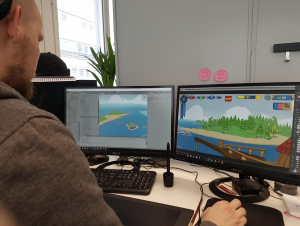Can Jurassic World Alive stand up to Pokemon Go?
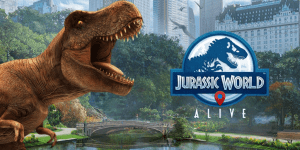
The market for location-based gaming is heating up this summer. We’re finally starting to see some major developers come out with an answer to Niantic’s Pokemon Go, a game that is now nearly 2 years old and going stronger than ever. Pokemon Go is a staple in the Top Grossing Charts, and with user numbers reaching an all-time high this month, it’s likely to continue. As such, there are many attempting to repeat its success. Niantic plan another title this summer, “Harry Potter: Wizards Unite”. NEXT Games have soft launched their “Walking Dead: Our World”. Ludia + Universal just launched “Jurassic World Alive” in tandem with the new movie launch.
Check out our Free to Play Game Design Bible Here

Three Location-based games launch this summer, can any repeat the success of Pokemon Go?
But many in mobile questioned how repeatable the success of Pokemon Go is. Most would say it’s success is heavily based on the Pokemon brand. So what chance do other Location-based games have?
Location-Based Gaming: The New Frontier for Retention
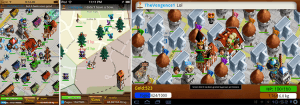
Location based gaming has been around since 2008. Games like Parallel Kingdoms by Per Blue
Location-based gaming has been public for awhile. Since smartphones had GPS, game developers have used location in their games. Parallel Kingdom, a game by Per Blue back in 2008 was one of the pioneers of this genre. Niantic’s Ingress in 2012 is an obvious iteration upon this genre. None of these games did remarkably well. So if all those games failed, and Pokemon Go succeeded, was it just the license or was it something else? What changed in 2016?

AR mode is more of a hinderance than a key gameplay element. Most players turn this off.
Some have pointed to the rise of Augmented Reality as a reason for Pokemon Go’s success — but this isn’t really true. While Pokemon Go does have Augmented Reality components to it, its novelty wears off fast. Many players report turning off AR mode pretty quickly after playing. True AR (using visual recognition to superimpose virtual items onto the real world) isn’t a major component of Pokemon Go. It’s just allowing players to play the catching mode using their camera. AR-mode actually just makes the catching gameplay harder and more inconvenient. AR was used for marketing rather than as a retention mechanic. So what really drives Pokemon Go’s staggering retention curve? (Seen below)
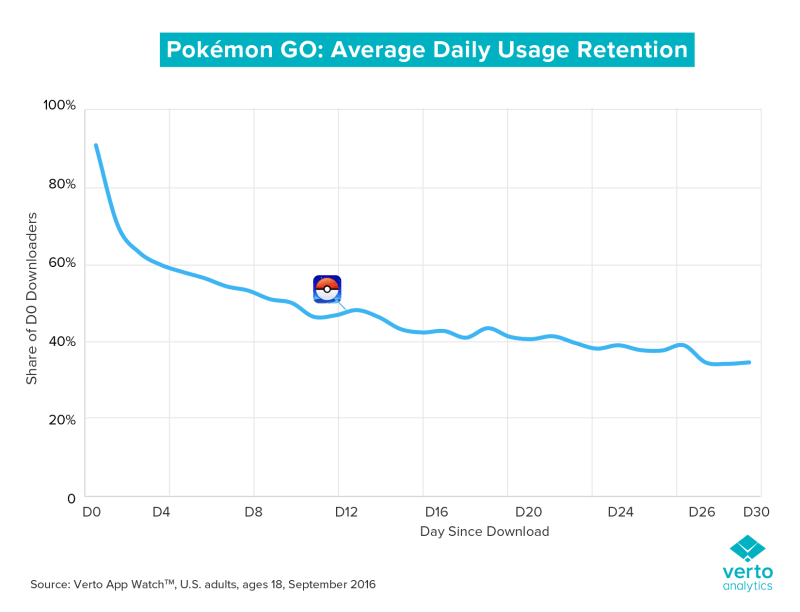
My hypothesis is that the success of Pokemon Go was partly based on branding, partly based on virality, but mostly because of the retention differences when using location as a trigger for gameplay.
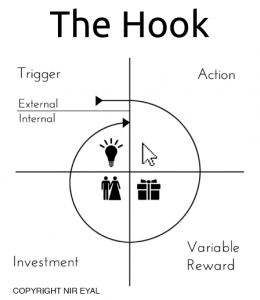
What I mean by trigger here comes from psychology. Taken from “Hooked” a book by Nir Eyal, we have a framework for what drives retention in apps and games.
To drive players to come back often:
- a player sees a visual trigger to enter the game (a player is bored, sees the icon on their phone)
- which has short, effective sessions (playing a quick match 3 level)
- with variable rewards (sometimes I win, sometimes I lose)
- that build long-term investment (reaching level 1000+ on a saga map)
All successful games use this loop to drive long-term retention. What changes in location-based gaming is the Trigger — the first step — pulling players into the game.
In typical mobile games, the trigger can be external (a push notification telling you your energy has refilled) or internal (I’m bored, let’s see if I can beat this level now). A location-based game has a new type of trigger — walking around in the world, being in a new place. Players that are stuck to games like Pokemon Go will tell you their trigger points — every time they’re getting a coffee, they check for Pokemon. Every time they are out at a restaurant, they check for pokemon. On their commute to work, they’re checking for pokemon.
If a game can attach itself to a commonly felt stimuli and use it as a trigger to play a game — this is an effective retention driver.
So location-based games, when they’re working, will build psychological triggers to play the game when you’re commuting, driving more repeat sessions and higher long-term retention. But do players have an appetite for multiples of these games?
Can a game with a lesser brand compete in this category? (sorry Jurassic Park, I love you but Pokemon is bigger)

Pokemon (Blue) vs Jurassic Park (Red) in Google Trends in the last 12 months. Even with the recent movie, Pokemon is a bigger brand.
Deconstructing Jurassic World Alive
Enter Ludia, a company that has proven over the last years to be confident in entering new genres and succeeding. Founded in 2007, they’ve focused on Facebook and mobile licensed games. They were acquired by Freemantle media in 2010, and have seen continued success since then. Associating with big brands, they’ve gone on to build consistent successes on mobile. Recently, they’ve built up the Jurassic Park games on mobile. Leveraging the brand and combining with the Dragonvale framework, they’ve carved out a success on mobile within a genre (Dragon Breeding) which has been out of the spotlight for years.

Their approach to taking the Jurassic Park brand and associating it with location-based gaming looks based upon Pokemon Go, but clearly trying to fix the aspects that were missing from the experience. Where Pokemon Go is a collector’s game, Jurassic Park is a competitive battle game.
The Core Loop
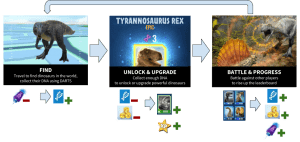
The core loop of Jurassic World Alive is simple yet effective. It builds upon the working framework of Pokemon Go, and adds a key element: battling.
- Find dinosaurs on your map, and send a drone to collect DNA from it. Based on how well you play the mini-game, the more DNA you collect.
- This DNA is converted into dinosaurs in a Clash Royale style system. The more DNA you collect, the faster you can unlock a dino and upgrade it.
- Using your upgraded dinos, you can battle other players, which rewards players with chests. These chests contain everything you need to restart the loop: coins and darts.
The keys here are the currency sources & sinks:
- Finding dinos takes darts, which can only be collected from battling and a daily free chest. So you need to battle to collect and upgrade.
- Coins are needed to upgrade, unlock, and fuse dinosaurs. Coins start off plentiful but become tighter and more strategic as you reach the end game.
- XP is gained only from unlock & upgrading. So levelling up is relative to how big & high levelled your collection is. Collecting & upgrading any dinosaur is helpful.
- Upgrading your dinosaurs is needed to keep battling. As you battle, your elo rating is improving, forcing you to match against more and more difficult players. In order to keep up with the matchmaking, you need to be constantly upgrading your dinosaurs.
Let’s go into each step in more detail:
Collecting Dinosaurs

The game’s main screen is the map. It takes a perspective view of a typical google map and shows you the locations of dinosaurs currently wandering your city. If you’re close enough to a dinosaur, you can send a drone out to collect DNA from it. If you’re not, you’re going to have to move closer.
For this mechanic, Ludia creates an upsell mechanic. The radius of being able to capture a dinosaur is pretty small for free players, but if you pay into their VIP system, you get an increased radius for collecting. A compelling reason for beginning + lazy players (like myself) to commit to playing the game. Very smart!
Besides this, Jurassic World Alive conveniently places a few dinosaurs near you every session. So even as a lazy player that mostly checks their devices in similar to locations, you can still make good progress. A must for location-based games.
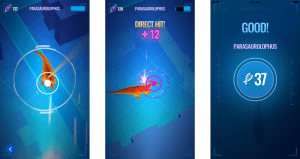
If you’re in radius, you can send a drone to pick up DNA from the dinosaur. This is a pretty compelling minigame of aiming with your drone and sending darts to collect DNA. A bit of timing, prediction and control wonkiness make it a pretty exciting minigame. Direct hits can get you large amounts of DNA, so being more accurate pays off big time.
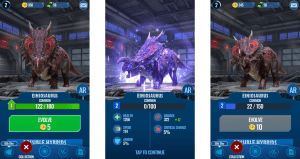
DNA is a precious resource, it’s similar to cards in Clash Royale. The more DNA you collect, the faster you can unlock and evolve a monster. Giving a very compelling reason to play well in the mini-game. This makes their progression significantly more skill-based than most, makes it more difficult to balance for different play types, but makes the DNA collecting minigame much more compelling. As you progress and start wanting to collect rarer and rarer dinos, you only have limited chances to collect the DNA, adding further pressure to be on the lookout for the best dinosaurs.
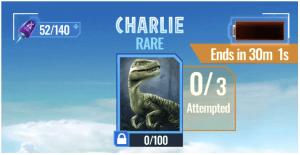
Long Term Retention: Fusion System
One interesting addition Ludia have added to the Pokemon Go/Clash Royale style system is the addition of Fusion:
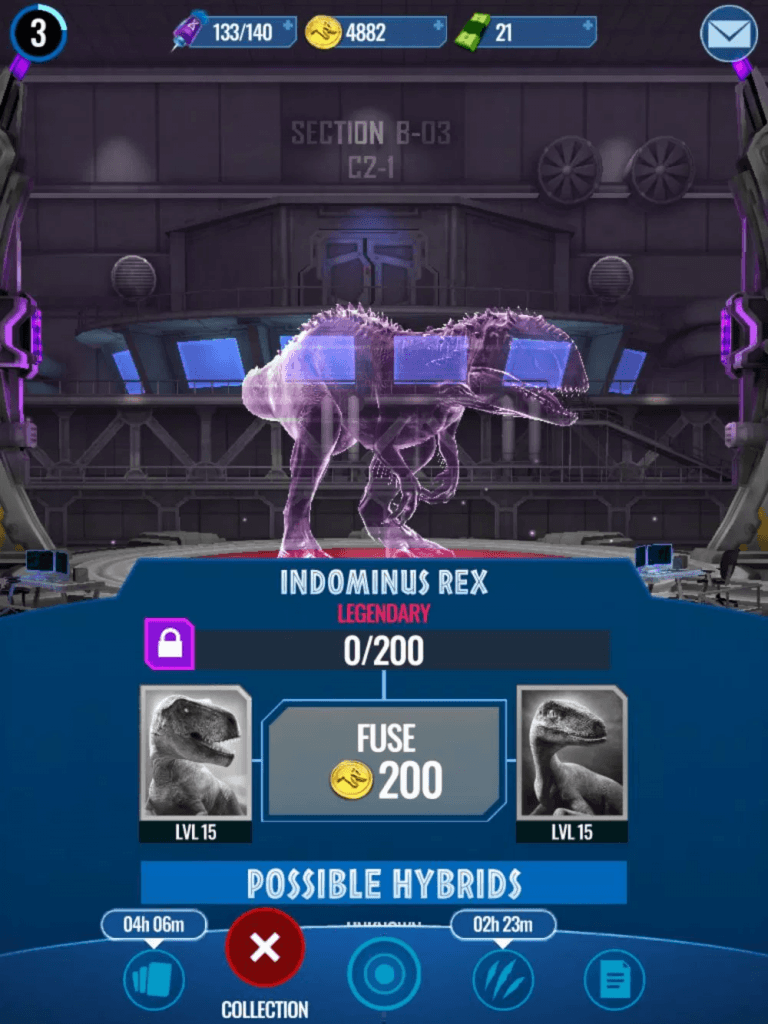
The fusion system allows players to create specific hybrids of dinosaurs. There are a number of pre-designed recipes which require you to combine two dinos (ex. Combining t-rex and raptor to create indominus, just like the movie). This typically requires both to be a high enough level as well as a modest fusion cost. This is how you can create legendary level dinosaurs.
It’s a smart tie in from the movie that adds significant depth to their chase for the best dinosaurs.
In the case of Clash Royale, it can get frustrating with some of those early cards not being of use in the endgame. Also having no visual change to a character after unlocking it feels less powerful. With the fusion system, having a goal to level up a set of characters to unlock a more powerful character is a good long term retention system.
So overall, Jurassic World Alive has a nice mix between Clash Royale and Pokemon Go, with some interesting additions. Being able to influence how much DNA/Duplicates you collect is great for players (less so for balancers), and adding the fusion system creates a visible long term goal.
The Battle
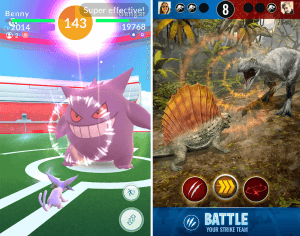
JW:Alive significantly builds upon Pokemon Go’s simplistic battle system.
Comparing Jurassic World Alive’s battle system to Pokemon Go’s, you can clearly see that Ludia took the weakest system from Niantic and improved on it substantially.
Pokemon Go opted for a system that is centered around their experience — location-based design. Instead of making battles central to their core loop, battles can only be done at certain locations (gyms), making battling tied to an overall social goal (take gyms for your team), and make it very asynchronous (the winner leaves a defending team for attackers to try to beat). The actual battle mechanic itself is really simplistic — bring 6 of your best pokemon in, and just tap madly on the screen to try to damage them as much as possible. There’s some skill in dodging and in selecting pokemon, but Pokemon Go’s battle system is very shallow that’s gotten plenty of criticism from their fanbase.
The Challenge of a 1v1 Battle
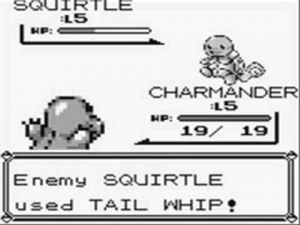
To be honest, Pokemon’s original battle mechanic wasn’t that great either. Since it was single player experience, the original Pokemon games were balanced very much in favour of the player. So they could get away with the game being pretty simplistic. When players started battling pokemon in PvP, there wasn’t alot of depth. The strategy usually was to keep swapping pokemon until you had the advantage on the field. Because it was a 1 on 1 turn-based battle, it didn’t leave a lot of room for countering and strategy. It’s why most turn-based PvP RPG games today typically have more fighters on the field (ex. 3v3 in Summoner’s War) or add a grid to move around units to create interesting countering tactics (ex. Fire Emblem Heroes).
Jurassic World Alive seems to have taken the original Pokemon style battling system and built it out so that it actually can function as a 1v1 PvP RPG battle with a healthy meta. Instead of dinosaurs having clear explicit strengths and weaknesses (ex. Water dinosaurs and weak against flying dinosaurs?) they’ve gone for a system where dinosaurs have much less obvious strengths and weaknesses. There’s no explicit rock-paper-scissors strategy, and it makes for a better game.
There are many types of dinosaurs, some with high health, some with quick attacks, some with high damage, some with status effects, and some as a hybrid. The strategy becomes trying to use your dinosaurs to the best of their abilities: having your high health dinos suck up damage, high attack dinos rip through without taking damage, and having your speedy dinos to do the final blow, preventing the opponent from attacking back. Overall, I counted 19 different attack types. This creates a nice base layer of strategy for a 1v1 game.
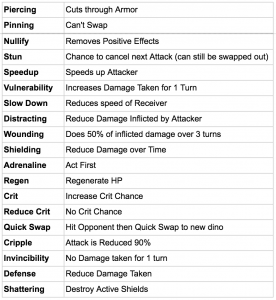
With status effects this also means that a dino’s strengths and weaknesses can change through a battle. Remember “Tail whip” from Pokemon? A useless move to increase damage taken by your opponent? — here in Jurassic World Alive it actually makes strategic sense. These moves have enough impact to make you second guess leaving your dinos in a weakened state.
Take out 3 dinos before your opponent does
The goal of the battle is to take down 3 opposing dinosaurs before your opponent does. You bring in 4 dinosaurs, and can switch as often as you’d like. Similar to pokemon however, swapping out your dino leaves them susceptible to a free attack by the opponent.
So typically what happens is there’s some mind reading of your opponent. You make assumptions when they will swap out their dinos and try to take advantage of them losing a move.
Overall this gives the PvP battles a good level strategy. You’re trying to counter the opponent’s, while preventing swapping at the wrong time. You’re trying to avoid your opponent from saving their speedier dinos, who can take down your weaker dinos without being hit back. The upgrades and matchmaking also keep battles intense — most battles feel like you lost because of skill.
However, some of the battle’s elements show that they can’t break away from the innate issues of a Pokemon style battle: a core strategy of the game is to try to guess what your opponent will switch to. Guess that your opponent will start with a heavy armor dino? Then start with an armor piercing one. Guess that your opponent will swap a weak dino before you can kill it? Then make them pay by using your special attack rather than your weaker one. This is fun to pull off, but call-your-bluff/mind-reading strategy isn’t going to last for the long term.
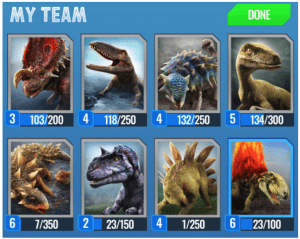
On top of this, your battle team is made up of 8 dinos, yet when you battle, it randomly selects 4 out of the 8. This feels like a tacked-on system to increase the pressure to upgrade more dinosaurs rather than increasing the strategy before the battle. As a player it means you have some arbitrary randomness about whether the strategy you wanted to use will pay off, and can mean that right from the onset of the battle you already feel like you’ve lost (you got a bad draw from move 1). While randomness can be good, this much pre-determined luck can make players feel helpless early in battle.
This points to an issue that the 1v1 gameplay has. It’s just too limiting. The in-game strategy hits a cap which turns into a mind-reading battle, and the out-of-game strategy is limited so they had to tack on a “random 4” system.
I wonder if the game’s battle system would have been better if they’d broken from the pokemon style design and instead gone with something like a 3v3 battle system. Increasing complexity, but increasing the depth substantially. There would be substantially more attack types, more in-game strategy. Makes swapping dinos a far more interesting choice, and makes directly countering a more nuanced strategy.
Regardless, the Jurassic World Alive battle system is far better than the tap fest that is Pokemon Go — I just wonder if it could have been even stronger with a 3v3 system.
Pacing & Progression
And just for good measure, to pace the battle system, Jurassic World Alive relies on the good ol’ chest system from Clash Royale. Instead of pacing you based on energy, players can only have 4 chests at a time, and each chest must be opened one at a time. Because of matchmaking and the importance of stats in the outcome of a battle, it prevents players from rushing too far ahead by winning too many battles. Eventually, you will need what’s in the chests in order to compete.
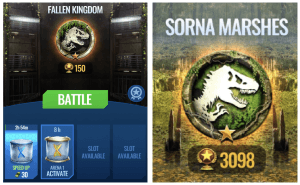
From Clash Royale: Chest Slots and Arena Tiers
Arena tiers are another borrowed feature from Clash Royale. Players earn trophies for victories, which unlock higher and higher tiers which contain bigger prizes and better dino DNA each time you win. This gives a clear, compelling reason to keep playing.
Comparing to Pokemon Go, my goal in the game is far more explicit and I can make progress towards it immediately: reach the next arena.
3 Reasons why it’s Working

Regardless of your thoughts of Jurassic Park IP or Location-based gaming, Jurassic World Alive is within the Top 100 grossing, and has sustained there since launch. While I think many would dismiss this as a “lesser Pokemon Go” — it clearly has done something right.
I believe that there are 3 key reasons why Jurassic World Alive has seen success so far:
#1 – Smart Merchandising
Merchandising — the features of a game that are typically there to upsell players towards spending money — are top notch in Jurassic World Alive. Ludia consistently have launched games that have taken the best merchandising practices and executed on them well. In Jurassic World Alive this really is showcased in their VIP System:

Jurassic World Alive showcases throughout the game the value of their VIP system. From the onset, you are constantly shown that a dinosaur is just out of reach on your map — the cure? Join VIP! This is an excellent conversion leverage point. On top of this, getting an epic incubator and increased supply drops makes the progression far easier.
The VIP system is also a subscription. Utilizing the latest trends in F2P, which is now even a common tactic in Hyper Casual games. The power of committing players to an ongoing subscription seems to be driving a lot of revenue these days (hopefully not too much off the back of forgetful users…).
#2 – Clear Progression & Goals
As mentioned above, one aspect I think Jurassic World Alive does far better than Pokemon Go is the visibility and clarity of their progression system and goal systems.
For Pokemon Go, the goal is mostly focused on completing your Pokedex. This is alright for collectors, but it doesn’t hit all player types. Jurassic World includes the Battle loop + arenas, which give a clear focus for battling your dinosaurs. Now there’s a way to clearly show off my progress and a competition I can engage in that will give me clear progress & clear recognition.
Comparing this to Pokemon Go, having to go to Gyms, and choosing a team which is far too large to feel impactful within makes the competitive goals far too end-game heavy. In the beginning, the goal is just to collect — and this is only compelling for so long.
#3 – Less Reliant on Location-Based Gameplay
Lastly, I think it was a smart choice for Jurassic World Alive to make their systems less dependant on the location-based gameplay. In Jurassic World Alive you can have many sessions without ever really caring about the map or moving to different locations.
Within Jurassic World Alive, usually there are a number of dinosaurs directly near me that helps me progress. These “freebies” may not be the optimal path, but still help me progress faster and give a reason to check my phone even when I’ve been in the same location for awhile (which, if you’re like lazy me, is common).
On top of this, the battle system & chest system not being location specific means that throughout the day when I’m not walking around I can still complete a meaningful session. I can open up chests, start the opening of the remaining. I can win some battles and fill up my slots. I can open up my free incubator.
Comparing to Pokemon Go, it instead relies a lot on location-based design. Incubators require you to remember to walk around with them on (which is a pain). Gyms are at specific locations, making you need to remember to check your phone at that location to make meaningful progress. While this is great for getting some location-based retention, it can make “regular” mobile sessions a pain in Pokemon Go.
Jurassic World Alive, on the other hand, is stronger because it has location-based elements, but you can still play the game often without needing to worry about where you are.
But can it hold up?
Looking at the grossing charts now, it looks like it will stabilize within the Top 150 grossing. While the movie is still in theatres and advertisements are running daily, they should be able to sustain here.
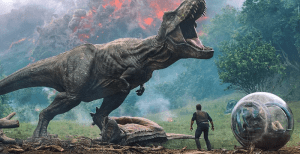
By prediction however is that it will fall, and will be tough to retain within the Top 250. This bump from movie goers and IP is inevitable, but sustaining at this level will still be difficult. This is partially because of the brand — its not Marvel — there isn’t a new movie every 6 months. It’s not Harry Potter — the fanbase isn’t nearly as large. The simple nature of the IP will be resistance for Jurassic World Alive.
From the design side there are also some issues:
The battle is effective, yet still too simple. Building out a lasting meta should be priority. Driving players to collect and upgrade a wider range of dinosaurs is crucial, and the current system of randomly picking 4 out of 8 isn’t strong enough. They could drive this width from some PvE gameplay, shifting the meta more explicitly in events, or from shifting the PvP to 3v3. Either can be a way to drive players to collecting & upgrading a wider range of dinosaurs to compete.
The social component is lacking. Where pokemon go has built this up over time, Alive still has ways to g and launched with less features than Pokemon did at launch. No lures, no chat, no clans. For now this is fine, but to take advantage of the location-based gameplay and drive local players to work together like Pokemon Go does, adding some ways for players to communicate & strategize locally would be simple but great addition.
Ludia is an excellent company which has proven time and time again to break into new categories with confidence and deliver on the live operations side. This game should be no different. I have no doubt that Ludia will be able to take the strong base of this game, respond to player feedback, extend the battle gameplay to last longer, design events that drive players back, and develop social features which will build up over time.
I expect this to be a staple on the Top Grossing chart, just not one to beat Pokemon Go. However, I don’t think that’s necessary for success here — what we should all take from this is that location-based games may be more interesting than we all once thought.
Summer of 2016 was the summer of Clash Royale’s gacha.
2017 was the summer of Battle Royale gameplay.
2018 may be the summer of location-based gaming.





